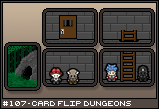| Three Hundred |
| - Index Page |
| - About... |
| - By Year |
| Collections |
| - Comp-Grid |
| - Procedural |
| - Tactics |
| - Tiny Crawl |
| - Misc |
| Previous | Mechanic #107 | Next |
|
![[cards1.png]](set06/img/entry107-cards1.png)
I'm going to begin with a simple gameplay overview, then get more into detail about the special mechanics. The general premise is that this is a two player boardgame, where one player plays the dungeon side and one player plays the heroes. The dungeon player creates a dungeon out of cards. How this dungeon will be built is still undecided, but it could be pre-made, built using points, or done in some sort of card drawing manner. In addition to the dungeon, the dungeon player also has a group of units that can move between cards. |
![[cards2.png]](set06/img/entry107-cards2.png)
The hero player starts off with a group of adventurers in the dungeon entrance card. The unexplored dungeon areas are covered with cards and are revealed as each room is first entered. Each turn, the player moves his units around between cards (each unit will have a speed of 1 to 3, indicating how many cards it can move per turn). A unit must stop when it enters a room with an enemy unit, or if it is the hero player's turn, into a a new room that is to be uncovered. Dungeon units can move through covered rooms, but can not use their special abilities. No more than three units per side can be in a room (six total). After both players move, it goes into the combat phase. Each player can initiate a single combat in any room that has both his units and enemy units. Combat is simple. Attacker adds up all the attack value for his units, then subtracts the total defense value for the enemy. If the result is greater than 0, that number of points must be subtracted from the defense's units, however the defense sees fit. Then, the defense returns the favor, assuming he still has units left to attack with after the damage is done. ![[cards4.png]](set06/img/entry107-cards4.png) For example: Ruby (Atk:4) and Hechter (Atk:2) fight against two demon knights (Def:2). The result is 4 + 2 - 2 -2 = 2, so the dungeon player must remove two hitpoints from his two demon knights. It's his choice how they are distributed. He can take two from one unit or one from both units.
![[cards3.png]](set06/img/entry107-cards3.png) The meat of this concept is that each room is a card, and cards can be stacked or flipped. For instance, take the cards with a door on them. Those are actually a stack of two cards. Once the door is opened, that card is popped off the stack, changing the room into whatever was below it (in this case, a treasure room). Room stacks can be used in other ways. For instance, the lock to the final boss could be a stack of four locked doors. As the players find keys or other ways to open the doors, the locks are popped off the stack. The dungeon player, meanwhile, could be working to push more locks on the stack to keep the door locked. ![[cards5.png]](set06/img/entry107-cards5.png) Each card has two versions of itself, printed on the front and on the back. Certain events in the game can cause cards to flip to their alternate versions. For example, the alternate sides of the ladders may be an unusable version of the ladder. You'd have to flip the two cards before you could use the ladder to change levels. Rooms themselves may affect combat in some ways. For instance, they may add defense to one side or another, or they may have a built in unit which can not change rooms or lose hitpoints, but still adds to the attack and defense in battles for that card. It could be that flipping a room's card changes it from favoring one side to favoring the others. ![[cards6.png]](set06/img/entry107-cards6.png) The final wrinkle in the card manipulation aspect is translucent cards. These are placed on top of an existing room to modify its contents in some way. Pictured above is a darkness card. When placed over a room, none of the room's effects trigger during battle. |
![[cards7.png]](set06/img/entry107-cards7.png)
Here's what a dungeon might look like with multiple effects in place. The red cards are hot rooms, green are poisoned air, and black are darkness. Notice that one room has both poison and darkness in effect.
|
